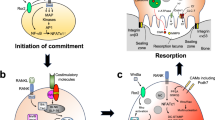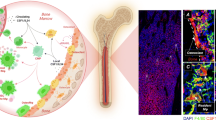Abstract:
Osteoprotegerin-ligand, also called Osteoclast Differentiation Factor or RANK-ligand, its receptor RANK and its decoy receptor Osteoprotegerin are key molecules regulating osteoclast differentiation and activation. In this view we discuss structure and expression of these molecules, the genetic models addressing their function and their role in in vivo models of osteoclast differentiation and activation. The new paradigm that has evolved from these studies, is not only important in normal bone homeostasis but also appears to play a role in different diseases that affect the skeleton, such as osteoporosis, inflammatory joint disease and cancer. It has opened a new era in bone research by increasing our molecular knowledge and providing new therapeutic targets in bone disease.
Similar content being viewed by others
Author information
Authors and Affiliations
Additional information
5 November 2000 / Accepted: 15 December 2000
Rights and permissions
About this article
Cite this article
Lories, R., Luyten, F. Osteoprotegerin and Osteoprotegerin-Ligand Balance: a New Paradigm in Bone Metabolism Providing New Therapeutic Targets. Clin Rheumatol 20, 3–9 (2001). https://doi.org/10.1007/s100670170095
Issue Date:
DOI: https://doi.org/10.1007/s100670170095




